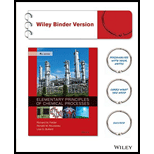
Freeze concentration is used to produce a fruit-juice concentrate. A stream of fresh juice containing
12 wt% soluble solids in water at 20°C is combined with a recycle stream to form a preconcentrate, which is fed to a crystallizer. The mixture is cooled in the crystallizer to —7°C, thereby crystallizing 20,000 kg/h of ice. A slurry leaves the crystallizer containing 10wt% ice and is fed to a filter. The filtrate, which contains 45 wt% dissolved solids, is removed as the process product. The remaining slurry, which contains all the ice and some concentrate (also containing 45% dissolved solids), is sent to a separator that cleanly removes all of the ice. The residual liquid is the recycle stream that combines with the fresh feed to form the preconcentrate.
- Determine the rates (kg/h) at which fresh fruit juice is fed and concentrate is produced, and the mass flow rate (kg/h) and solids concentration of the preconcentrate.
Want to see the full answer?
Check out a sample textbook solution
Chapter 8 Solutions
Elementary Principles of Chemical Processes, Binder Ready Version
Additional Engineering Textbook Solutions
Elements of Chemical Reaction Engineering (5th Edition) (Prentice Hall International Series in the Physical and Chemical Engineering Sciences)
Process Dynamics and Control, 4e
Automotive Technology: Principles, Diagnosis, And Service (6th Edition) (halderman Automotive Series)
Computer Science: An Overview (12th Edition)
Modern Database Management (12th Edition)
Thinking Like an Engineer: An Active Learning Approach (3rd Edition)
 Introduction to Chemical Engineering Thermodynami...Chemical EngineeringISBN:9781259696527Author:J.M. Smith Termodinamica en ingenieria quimica, Hendrick C Van Ness, Michael Abbott, Mark SwihartPublisher:McGraw-Hill Education
Introduction to Chemical Engineering Thermodynami...Chemical EngineeringISBN:9781259696527Author:J.M. Smith Termodinamica en ingenieria quimica, Hendrick C Van Ness, Michael Abbott, Mark SwihartPublisher:McGraw-Hill Education Elementary Principles of Chemical Processes, Bind...Chemical EngineeringISBN:9781118431221Author:Richard M. Felder, Ronald W. Rousseau, Lisa G. BullardPublisher:WILEY
Elementary Principles of Chemical Processes, Bind...Chemical EngineeringISBN:9781118431221Author:Richard M. Felder, Ronald W. Rousseau, Lisa G. BullardPublisher:WILEY Elements of Chemical Reaction Engineering (5th Ed...Chemical EngineeringISBN:9780133887518Author:H. Scott FoglerPublisher:Prentice Hall
Elements of Chemical Reaction Engineering (5th Ed...Chemical EngineeringISBN:9780133887518Author:H. Scott FoglerPublisher:Prentice Hall
 Industrial Plastics: Theory and ApplicationsChemical EngineeringISBN:9781285061238Author:Lokensgard, ErikPublisher:Delmar Cengage Learning
Industrial Plastics: Theory and ApplicationsChemical EngineeringISBN:9781285061238Author:Lokensgard, ErikPublisher:Delmar Cengage Learning Unit Operations of Chemical EngineeringChemical EngineeringISBN:9780072848236Author:Warren McCabe, Julian C. Smith, Peter HarriottPublisher:McGraw-Hill Companies, The
Unit Operations of Chemical EngineeringChemical EngineeringISBN:9780072848236Author:Warren McCabe, Julian C. Smith, Peter HarriottPublisher:McGraw-Hill Companies, The





